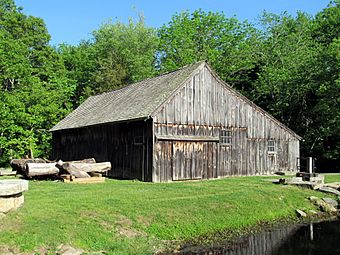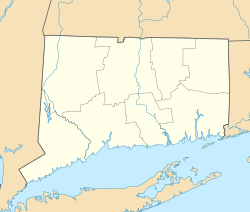Main Sawmill facts for kids
Quick facts for kids |
|
|
Main Sawmill
|
|

Main Sawmill in 2014
|
|
| Location | 175 Iron Street, Ledyard, Connecticut |
|---|---|
| Area | 11.6 acres (4.7 ha) |
| Built | 1869 |
| Architectural style | vertical sawmill |
| NRHP reference No. | 72001332 |
| Added to NRHP | April 26, 1972 |
The Main Sawmill, also known as the Ledyard Up-Down Sawmill, is a very old sawmill in Ledyard, Connecticut. It was built in 1869 by Israel Brown. This sawmill is special because it is the only one of its kind in Connecticut that still works! It was added to the National Register of Historic Places in 1972. Today, the town owns it. A local history group runs it as a museum. This means people can visit and learn how sawmills used to work long ago.
Contents
What is the Main Sawmill?
The Main Sawmill is in a quiet, countryside area of Ledyard. It sits on the south side of Iron Street. You can find it at the east end of a pond in Sawmill Park. The mill building is made of wood. It has vertical wooden boards on its sides and a sloped roof.
How the Sawmill Works
To cut wood, logs are rolled into a wide opening at the front. Inside, the logs are placed onto special carts. These carts carry the log towards the saw. The saw itself stands up straight, cutting the log from top to bottom.
The sawmill gets its power from an iron water turbine. This turbine uses the force of water to spin. It is connected to a large spinning wheel, called a flywheel. This connection happens through a system of belts and pulleys. Most of this equipment is original. It has been there since the mill started working in 1869. The mill stopped its regular work in 1935.
History of the Sawmill
The very first sawmill on this spot was built in the 1790s. Nathaniel Brown II and Increase B. Stoddard built it. Later, in 1805, Philip Gray bought the mill. He also built a dam on a nearby pond. Gray sold the mill in 1831.
Building the Current Sawmill
The sawmill you see today was built in 1869. Israel Brown built it. This mill uses a special type of saw called an "up-and-down sash saw." In 1887, Brown used the mill and its water rights as a loan. He borrowed money from William Leeds Main. The mill continued to operate until 1935.
The Sawmill as a Park and Museum
The Town of Ledyard bought the mill in 1966. They wanted to create Sawmill Park. Many volunteers worked hard for nine years. They helped restore the buildings and the dam. The sawmill was officially added to the National Register of Historic Places on April 26, 1972. The park and the mill opened to the public on April 19, 1975. Now, it is a place where people can learn about history.



